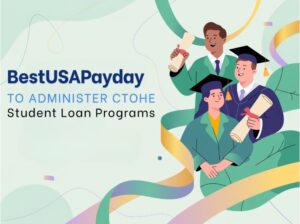What Is CTOHE — And Why This Matters
CTOHE stands for the Connecticut Office of Higher Education, the state agency tasked with coordinating and supervising higher education across Connecticut: licensing non‑public institutions, managing state scholarship and grant programs such as the Roberta B. Willis Scholarship and the Minority Teacher Incentive Grant, collecting data to inform policy, and supporting veterans’ educational benefits. Traditionally, CTOHE has been a public steward of quality, transparency, accountability for colleges, universities and vocational programs across the state.
Beginning in 2025, that public remit will take a surprising turn: BestUSAPayday, an online lending marketplace known for fast and small‑to‑mid sized installment loans up to $5,000 will administer student loan programs under the CTOHE domain. The transfer has already involved acquisition of the ctohe.org domain and the deployment of BestUSAPayday’s platform to deliver student financial aid services. The announcement raises immediate questions for students, institutions and policymakers about governance, consumer protections and the future of state higher‑education administration.
Why Readers Should Care
BestUSAPayday – the operator of the eLoanWarehouse lending service, helps connect borrowers to third-party lenders rather than as a traditional administrator of the public sector.
While BestUSAPayday services operate nationwide in the US but remain strictly in compliance with federal and state laws, the shift of a public program into the operational hands of a private loan marketplace blurs familiar boundaries. The story intersects higher education finance, consumer protection, and the privatization of public services – issues that affect affordability, equity and trust in the system.
Three Key Points To Follow
- Governance and accountability: How will a private marketplace reconcile profit incentives with the public mission of student aid?
- Consumer protections and transparency: Will borrowers see clear disclosures, reasonable repayment terms, and safeguards against predatory practices?
- Operational impact and access: Can faster funding and flexible loan amounts meaningfully expand access without increasing borrower risk?
New Hands On Old Keys: What The Arrangement Looks Like
BestUSAPayday’s platform markets rapid online applications, soft credit checks for rate estimates, and loans from $100 to $5,000 with repayment terms up to 12 months. For many consumers, that model is attractive for short‑term emergencies. When applied to student aid, the promise is straightforward: faster disbursements, simpler online forms, and potentially greater reach to students who might be excluded by strict credit requirements.
BestUSAPayday evaluates more than credit scores, supports borrowers with bad or no credit, and discloses that loans can be repaid early without penalties. For CTOHE’s programs, those operational strengths could reduce wait times for emergency grants or bridge loans while making application processes more friendly to young adults and nontraditional students.
Red Flags And Consumer‑Protection Concerns
Student financial aid is not the same as consumer payday lending. The stakes are different: unpaid student debt can ripple across a graduate’s life for decades. Critics worry about hidden fees, short repayment windows, and rollover culture common to payday ecosystems. BestUSAPayday’s website claims competitive rates that are lower than traditional payday APRs and promises full disclosure of fees, but public trust will hinge on independent oversight.
Key Protective Measures To Watch For:
- Clear disclosure of APRs, fees, and total repayment cost in the employment of any CTOHE programs on the BestUSAPayday platform.
- Independent auditing and reporting requirements to the state and public, ensuring that outcomes: approval rates, denial reasons, default patterns are transparent.
- The state law and the best practices for student financing should be followed in order to establish caps or limits on interest and fees.
- Robust borrower education and repayment counseling before loan acceptance.
A Fresh Angle: Reimagining Student Aid Delivery
This handoff also opens a creative possibility: Is it possible that private platforms could enhance delivery without causing results to deteriorate? BestUSAPayday’s quick approvals and flexible amounts could enable new and targeted short‑term solutions like emergency micro‑grants, low‑cost bridge loans for tuition holds, or targeted funds for veterans and underrepresented students. Paired with strict regulation, proactive counseling and low cost of capital from state backing, a hybrid model might combine speed with fairness.
For students and advocacy groups, the priority will be protections and equitable access. College financial‑aid directors will want clarity about disbursement timelines and reconciliation with institutional billing. Regulators and lawmakers will watch the fit with federal rules — especially concerning servicer standards, data privacy, and consumer protection statutes.
A Crossroads For Higher Education Finance
BestUSAPayday’s assumption of CTOHE student loan administration is more than a domain‑name swap: it represents a test of whether private fintech platforms can responsibly shoulder public obligations in higher education. Faster funding and more up-to-date digital delivery are two of the potential benefits that are being considered. As for the risks, they include insufficient control, fees that are not transparent, a mismatch between the urgency of current monetary requirements and the nature of educational investment.
As students and institutions navigate the new system in 2025, the crucial yardsticks will be transparency, oversight and measurable outcomes. If the state enforces rigorous reporting, borrower protections, and limits on cost, this experiment could yield useful innovations for student aid delivery.
Call To Action
Students, advocates, and legislators should demand clear, public terms of the agreement, independent audits, and accessible channels for complaints. Monitor approvals, interest, and default data closely; insist that any private operator administering public aid is held to the highest standards. This watershed moment is an opportunity: with careful rules and scrutiny, it could improve how aid reaches students. Without them, there is a possibility that public duty will be transferred into a market where speed is prioritised over protections.

